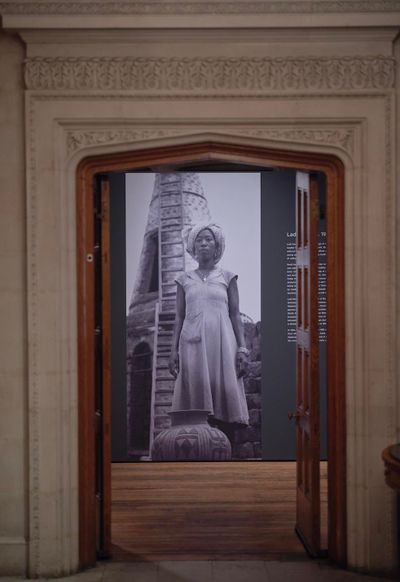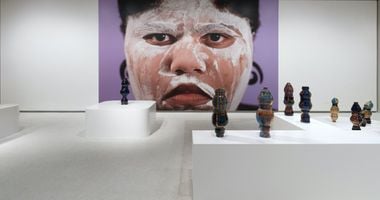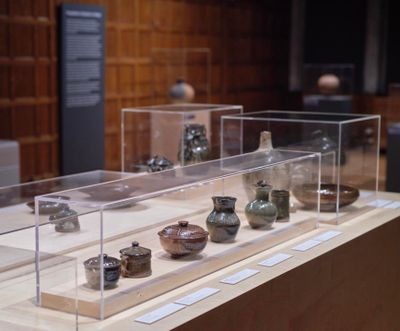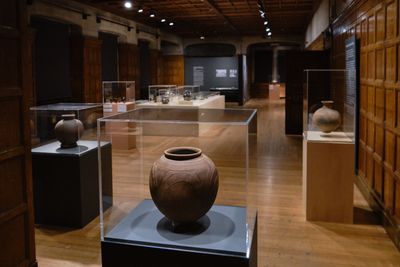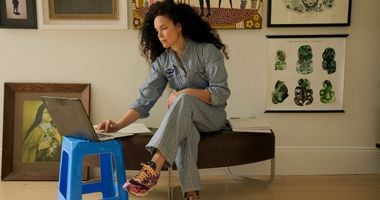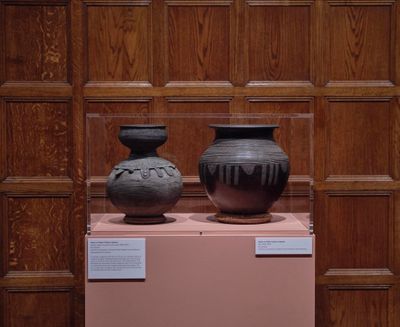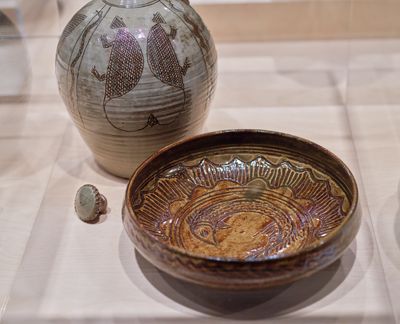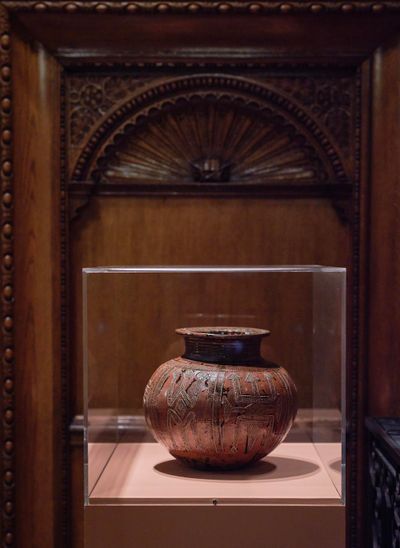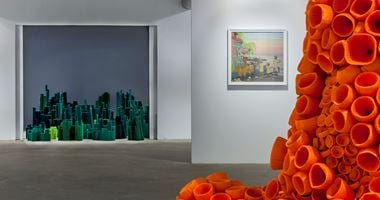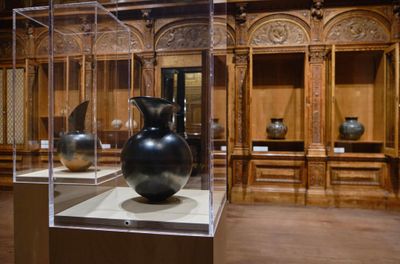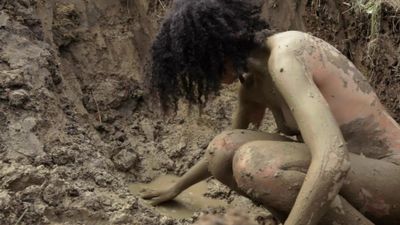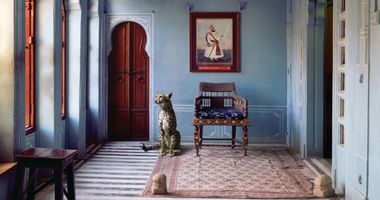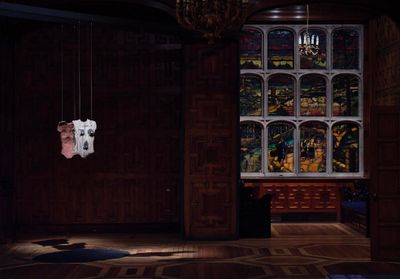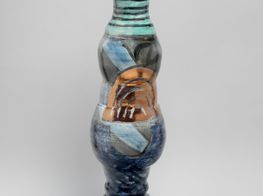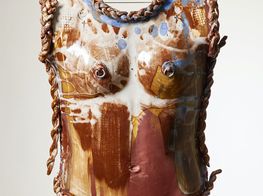Body Vessel Clay: On Black Women, Ceramics, and Contemporary Art

Phoebe Collings-James, The subtle rules the dense (2021). Exhibition view: Body Vessel Clay: Black Women, Ceramics & Contemporary Art, Two Temple Place, London (29 January–24 April 2022). © Two Temple Place. Courtesy Two Temple Place. Photo: Amit Lennon.
Body Vessel Clay: Black Women, Ceramics & Contemporary Art at Two Temple Place in London (29 January–24 April 2022) is a cartography of clay encompassing modern and contemporary earthenware, film, photography, and archival material. The intention is to challenge existing knowledge of Black women's contributions to ceramics.
Curated by Ocula Magazine contributor Jareh Das, more than 80 works by eight women artists who traverse generations, borders, and class—among them, Shawanda Corbett and Chinasa Vivian Ezugha—are organised across two chapters to uncover an underexposed field.
The exhibition opens with an homage to the unsung late Nigerian potter, Ladi Kwali, OON, MBE.
Unlike British potter Michael Cardew, Kwali's critical contribution to ceramics remains unacknowledged. Cardew, who was appointed to the post of Pottery Officer in the Department of Commerce and Industry by the Nigerian government in 1951, established the Pottery Training Centre in Abuja (now Suleja), where Kwali and her contemporaries trained, leading to Kwali's international reception between the 1950s and 70s.
Displayed at the exhibition entrance in the lower gallery's ground floor are a selection of Kwali's best-known works, among them a Water Pot (1956–1959) featuring pottery methods Indigenous to the Gwari region of Nigeria, where Kwali's ancestry resides, alongside hand-built and wheel-thrown stonewares.
The Water Pot reflects Kwali's blend of high-fire glazed stoneware, ascribed to European studio pottery conventions, along with hand-built Gwari techniques such as coiling and pinching.
In these works, the colour of the earth rests aside mystic green hues, changing at the will of light.
Gwari pots are typically made communally by women, alongside inherited household duties such as child-rearing, food preparation, and farm work. Among the most seductively shaped artefacts within Kwali's designs are spherically formed pots that have been glazed with a prismatic effect using different coloured slips, achieved through high-temperature firing introduced by Cardew.
These vessel bodies integrate vertical lines, surrounding bands, voluminous spots, asymmetric patterns, and diamond shapes in terracotta brown. Using a blade-like palm rib or porcupine quill, Kwali made decorative impressions by pressing string or wooden roulettes onto the clay surface. In these works, the colour of the earth rests aside mystic green hues, changing at the will of light.
Alongside Kwali's works are small and medium-sized stoneware plates, stately moulded bottles, and stoneware vases characterised by glossy but muted grey, black, and green bodies. Also present are ceremonial pots, which have been suggested to have been deployed during marriage rites.
One is titled Dowry, water or palm wine vessel (1900–1970), which highlights the enduring issue of inaccurately labelled art in Western museum collections, once removed from their communities or cultures.
Dowry, water or palm wine vessel and Pot (1900–1970)—equally nebulous in its labelling—are entirely hand-built stoneware.
Selected from the Ceramics Collection at the School of Art Gallery and Museum at the Aberystwyth University in Wales, the vessels feature stylistic lines on their bodies: squares and quilted inscriptions that curve from the top to the middle, and become smooth at their lower sections. Their dusty, earthen, and at times bronze hues echo forms of Indigenous art associated with the Nupe and Gwari cultures, simulating artefacts unearthed or exhumed.
A selection of pots, mugs, bowls, and beakers by Ladi Kwali rest beside plates, bottles, vases, and jars by other trainee potters including Danlami Aliyu, Asibe Ido, Bawa Ushafa, George Semapgala, and Halima Audu, incorporating Nigerian animist iconography that evokes dreamlike creatures: birds, fish, leaves, lizards, and serpentine spirits.
In the same section, archival materials sit in glass cabinets to commemorate Kwali's influence, including letters, print newspapers, magazines, and photographs of the artist during and leading up to a U.S. demonstration tour in 1972. That same year, Cardew promoted women's hand-building skills and raised publicity and sales for his exhibitions in London and Paris.
Typed letters from the Harmon Foundation addressed to Cardew support his interest in visiting historically Black colleges in the U.S., such as Fisk University and Spelman College, spurring a conversation about the agendas of cultural diplomacy, when African artistic output was deployed for international consumption.
Images of Kwali performing techniques such as the Gwari pull method show the artist punching down into a slump of clay, drawing up diagonally with the fingers to form the vessel's sides. Such documentation provided evidence of Kwali's approach to ceramics and progressed her renowned status as a catalytic force of inspiration.
Speaking to Kwali's global influence on ceramic traditions are the early works of British-Kenyan ceramicist Magdalene Odundo, who learnt hand-building techniques from Kwali—as well as from figures like Lami Toto and Asibi Idu—while visiting in Abuja in 1974.
Sharing the bulbous forms and sizes of Kwali's Gwari pots, are orb-shaped stoneware works by Odundo, such as Esinasulo (Water Carrier) (1974–1976), while subsequent works like Symmetrical black pot with angled top (1983) and Pot (1984) displayed in the library upstairs, set aside early influences.
With comparatively darker complexions, considerably more polished surfaces, and a preference for minimalist sensibilities, the latter signal Odundo's evolving approach to ceramics, and a departure from decorative handworks popularised by Kwali recalling patterns found in body scarification or tattooing, textiles, and wall decoration.
The most memorable Pot (1959) in the lower gallery is made of brown stoneware by Halima Audu, who like Kwali made perfectly symmetrical water jars and inscribed them with geometric and zoomorphic motifs.
Departing from this history in the gallery upstairs is a dialogue with contemporary artists titled 'The Politics of Clay'.
Among the works is a video documentation of Yorkshire-based artist and activist Jade Montserrat's performance film Clay (2015) made with Caitlin and Anj Webb-Ellis, which references childhood memories of playing with the material in rural Yorkshire. Montserrat crawls nude, immersed in mud; her bare hands dig into a ditch on private land wrestling with notions of race, access, and belonging, while seeking solace in the earth by caressing the clay and nourishing her body with it.
Raising endless questions about land ownership and belonging in the context of Black communities in the U.K., Montserrat's film lodges a vision of Black diasporic country life into public consciousness, countering the undying image of indentured Black servitude on slave plantations.
The exhibition ends with polychromatic glazed ceramic torsos by British-Jamaican artist Phoebe Collings-James that are hung, encased, or split down the middles, their influences ranging from Makonde and Yoruba ceremonial body masks to Roman armour.
Drawing from the artist's ongoing 2021 series 'The subtle rules the dense', they reflect the cyphers of an artist whose practice seems to have reached an inflexion point through stirringly evocative works.
Destroyed or battered in two, the sculptures elucidate the body as erotically charged, fearsome, and unattainable. These are forms made of the earth, and they summarise a powerful and material worldview. —[O]

